This article is more than 5 years old.
Agriculture is justly thought to be the most ancient art; and it is certainly by far the most useful, necessary and beneficial. The subsistence and welfare of mankind depend more on it than on any, or all others: And all other arts would soon be useless, were the culture of the surface of the earth neglected.
– Samuel Deane, The New England Farmer
The Grant Wood and the American Farm exhibit at Reynolda House Museum of American Art has Wake Foresters thinking about our farm stories. One book in the ZSR Library Special Collections tells the story of farming and its importance in the newly independent United States.
In the years immediately following the American Revolution, Samuel Deane, Vice-President of Bowdoin College and a charter member of the American Academy of Arts and Sciences, saw a need for a practical book of information for the American farmer. A pre-publication advertising flyer that circulated in 1787 assured prospective readers that The New England Farmer would be “a more complete System of Husbandry than has been before published in so small a compass: the only one that has been attempted in this Country, or that is adapted to its Circumstances.”
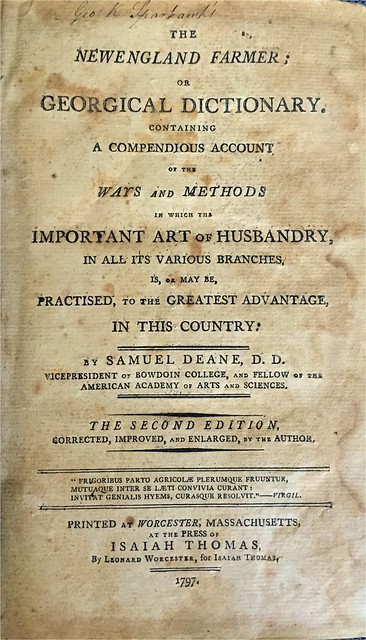
The first edition was published in 1790 and proved popular enough that a second, revised edition appeared in 1797. ZSR Special Collections holds a copy of this second edition.
Samuel Deane based his compendium on various European sources, but he adapted their advice for the specific needs of his American readers. As Deane observed in his preface to the second edition:
Though the productions of English writers may be perused by the judicious to great advantage, it would be unadvisable, and perhaps ruinous, for our farmers to adopt the methods and culture in gross, which they recommend to their countrymen. Local circumstances so widely differ in the two countries, that, in many cases, the right management in the one must need be wrong in the other.
In addition to filling a practical need for agricultural advice, The New England Farmer also tapped into the nationalist fervor of the post-Revolution years. Deane commented in the preface that he
has had more zeal and courage in attempting to promote improvements in agriculture, since the happy termination of the late struggle for independence than before. Our holding the rank of a free and independent nation allows us to consider the country as indisputably our own, and ourselves as monarchs over our farms. … [T]he most forcible reason for our cultivating this art, is the indispensable necessity of it, to enable us to live as becomes an independent people.
Published by Isaiah Thomas, the most prominent American printer of the time and an ardent supporter of American independence, Deane’s book introduced ideas of the European Agricultural Revolution in a concise and straightforward encyclopedia suitable for a working farmer.
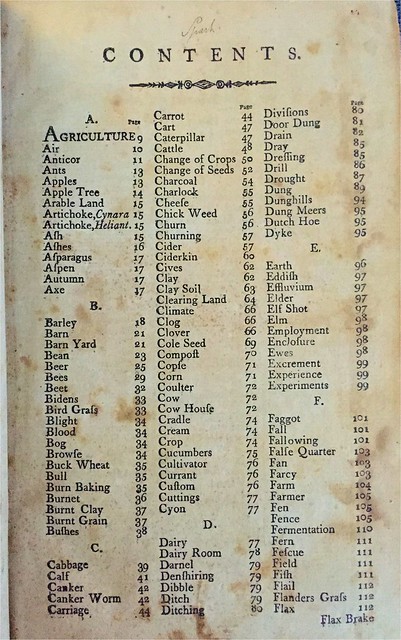
Deane apparently expected some resistance among American farmers to the “new methods of management proposed” in The New England Farmer. But he pleaded with readers to keep an open mind:
[I]t is expected that what is written will be censured by many, who have confirmed themselves in wrong practices by inveterate habits. But if persons will only be so fair as to allow, that there is a possibility of some want of perfection in their present established practice. . . they will then see it is reasonable to give a candid hearing to any new scheme of improvement suggested, and to plausible arguments offered in support of its utility.
The New England Farmer includes a lengthy entry on agricultural innovator Jethro Tull:
NEW HUSBANDRY… chiefly differs from the old husbandry, in this, that the soil is tilled while the plants to be nourished are growing in it. This mode of culture was introduced into England, by the ingenious Jethro Tull, Esq. who wrote largely and repeatedly on the subject….
And Deane offers a summary and discussion of the new theories about crop rotation:
CHANGE of CROPS, a method of cultivating different sorts of vegetables in succession on the same piece of ground, with a view to make tillage lands more profitable in the long run; and at the same time, to prevent exhausting them of the strength.
Those who believe that the food of different plants is different, cannot but look on the changing of crops as a matter of essential importance. For, on their hypothesis, land which is worn out with one sort of vegetable, may be in good order to produce a large crop of another sort….
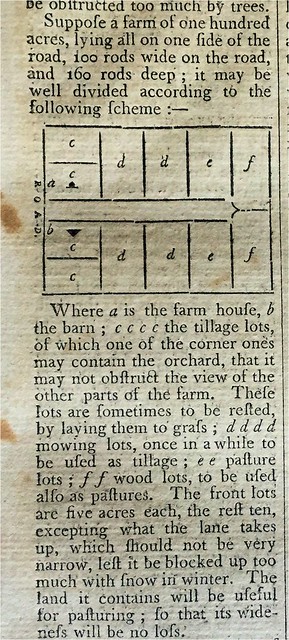
But he also records some innovations that never caught on, like the ripling cart, a harvesting machine (precursor to Patrick Bell’s reaper?) that literally put the horse before the cart:
RIPLING CART, a machine to perform the work of reaping. In a pamphlet published at New-york, in the year 1790, by F. C. H. B. Pollintz, a ripling cart, as he calls it, is recommended for the harvesting of wheat. In the operation the heads of the corn are taken off by seven combs, each four feet in length. The combs are strongly fastened, at equal distances, to a roller, which is turned by bands from the wheels of the cart, and which throws the heads into the cart, which is pushed forward by one horse, harnessed with his head towards the cart.
Of course, The New England Farmer was not all newfangled theories. Most of Deane’s entries are practical and non-controversial. He offers an appreciation of bees…
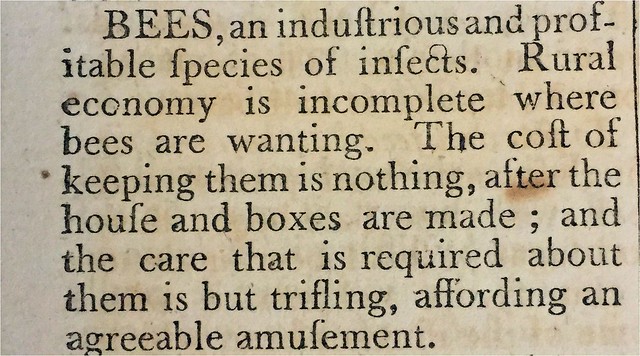
…and a remonstrance on rats.

A discussion of cows…
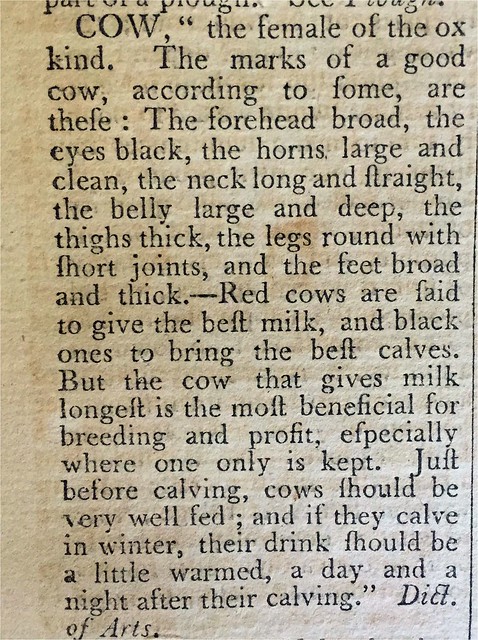
… and ploughs.
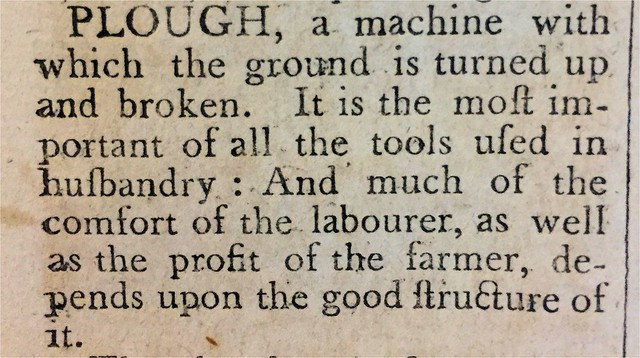
Only the letter X left Deane stymied:
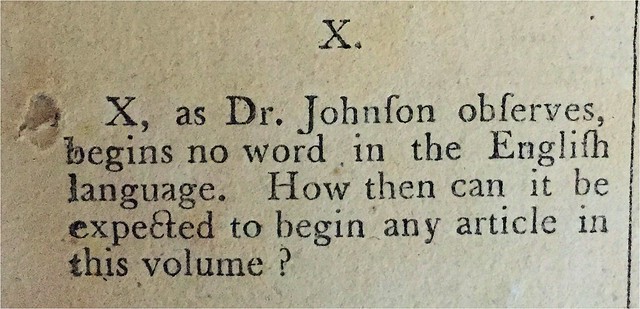
Many other books and periodicals on American agriculture appeared in the 19th century, but the large number of surviving copies of The New England Farmer attest to its persistent popularity. The original owner of ZSR’s copy was George King Sparhawk (1771-1848), a farmer and merchant from Conway, New Hampshire. Sparhawk purchased the book as a young man in 1799 and proudly signed his name on the dedication page.
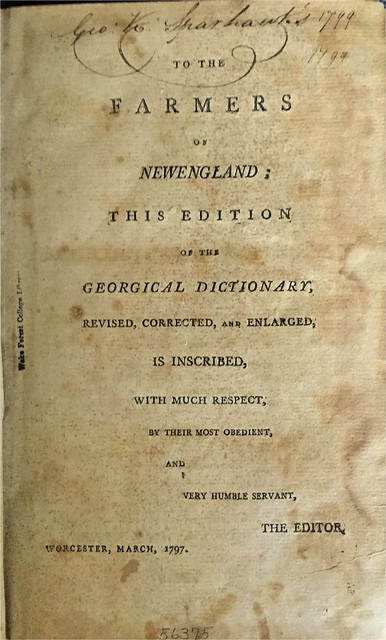
And he kept and used the book for the rest of his life, as attested by a receipt tucked into the pages, dated June 1842, from the Oxford [Maine] Woolen Factory.
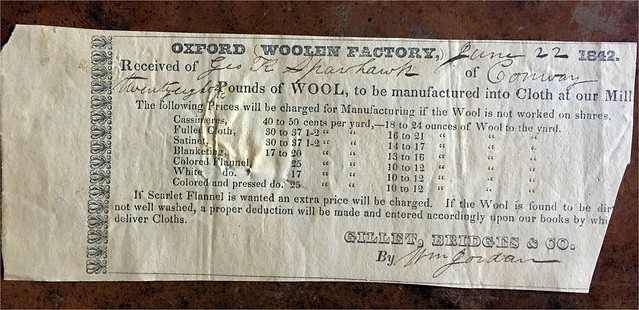
The book made its way to Wake Forest sometime in the 1930s. It was purchased as part of Wake Forest’s participation in the the McGregor Plan for the Encouragement of Book Collecting by American College Libraries, a program designed to help small colleges purchase primary source materials in American history.

2 Comments on ‘The New-England Farmer; or, Georgical Dictionary, by Samuel Deane (2nd edition, 1797)’
Great companion to the Grant Wood/Farming in America exhibit at Reynolda House. Thank you!
I didn’t know about the McGregor Plan — do we know who at Wake Forest was responsible for our participation and the lovely benefits such as this book?